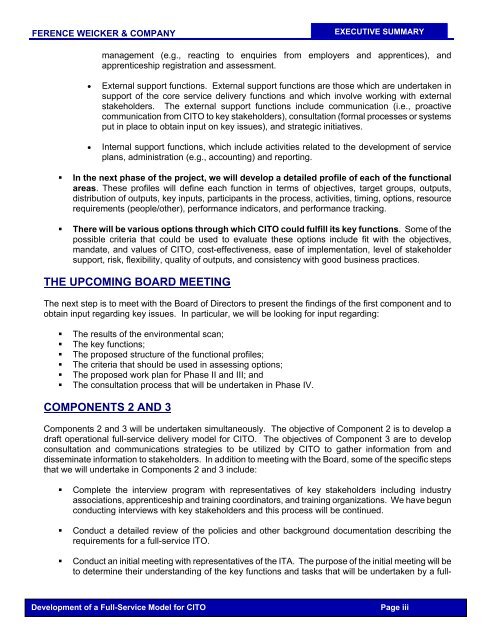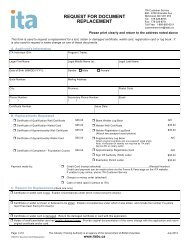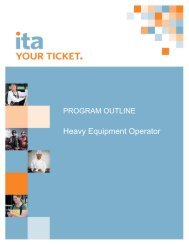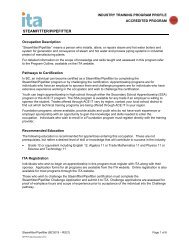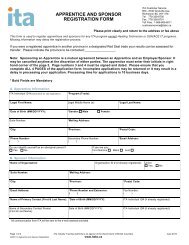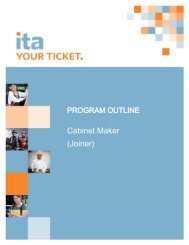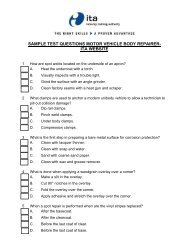CITO - Phase I Report - Industry Training Authority
CITO - Phase I Report - Industry Training Authority
CITO - Phase I Report - Industry Training Authority
You also want an ePaper? Increase the reach of your titles
YUMPU automatically turns print PDFs into web optimized ePapers that Google loves.
FERENCE WEICKER & COMPANY<br />
EXECUTIVE SUMMARY<br />
management (e.g., reacting to enquiries from employers and apprentices), and<br />
apprenticeship registration and assessment.<br />
• External support functions. External support functions are those which are undertaken in<br />
support of the core service delivery functions and which involve working with external<br />
stakeholders. The external support functions include communication (i.e., proactive<br />
communication from <strong>CITO</strong> to key stakeholders), consultation (formal processes or systems<br />
put in place to obtain input on key issues), and strategic initiatives.<br />
• Internal support functions, which include activities related to the development of service<br />
plans, administration (e.g., accounting) and reporting.<br />
� In the next phase of the project, we will develop a detailed profile of each of the functional<br />
areas. These profiles will define each function in terms of objectives, target groups, outputs,<br />
distribution of outputs, key inputs, participants in the process, activities, timing, options, resource<br />
requirements (people/other), performance indicators, and performance tracking.<br />
� There will be various options through which <strong>CITO</strong> could fulfill its key functions. Some of the<br />
possible criteria that could be used to evaluate these options include fit with the objectives,<br />
mandate, and values of <strong>CITO</strong>, cost-effectiveness, ease of implementation, level of stakeholder<br />
support, risk, flexibility, quality of outputs, and consistency with good business practices.<br />
THE UPCOMING BOARD MEETING<br />
The next step is to meet with the Board of Directors to present the findings of the first component and to<br />
obtain input regarding key issues. In particular, we will be looking for input regarding:<br />
� The results of the environmental scan;<br />
� The key functions;<br />
� The proposed structure of the functional profiles;<br />
� The criteria that should be used in assessing options;<br />
� The proposed work plan for <strong>Phase</strong> II and III; and<br />
� The consultation process that will be undertaken in <strong>Phase</strong> IV.<br />
COMPONENTS 2 AND 3<br />
Components 2 and 3 will be undertaken simultaneously. The objective of Component 2 is to develop a<br />
draft operational full-service delivery model for <strong>CITO</strong>. The objectives of Component 3 are to develop<br />
consultation and communications strategies to be utilized by <strong>CITO</strong> to gather information from and<br />
disseminate information to stakeholders. In addition to meeting with the Board, some of the specific steps<br />
that we will undertake in Components 2 and 3 include:<br />
� Complete the interview program with representatives of key stakeholders including industry<br />
associations, apprenticeship and training coordinators, and training organizations. We have begun<br />
conducting interviews with key stakeholders and this process will be continued.<br />
� Conduct a detailed review of the policies and other background documentation describing the<br />
requirements for a full-service ITO.<br />
� Conduct an initial meeting with representatives of the ITA. The purpose of the initial meeting will be<br />
to determine their understanding of the key functions and tasks that will be undertaken by a full-<br />
Development of a Full-Service Model for <strong>CITO</strong> Page iii


